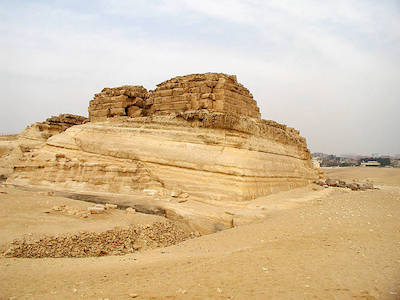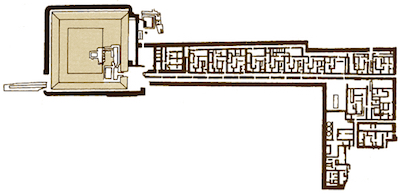Queen Khentkaus I (of the late fourth dynasty, of the Old Kingdom) was buried in a pyramid complex referred to as LG 100 and G 8400 at Giza.
Stepped Tomb
Her tomb is a large two-stepped structure which was initially thought to have been an unfinished pyramid which was ascribed to Shepseskhaf. It was referred to by some (e.g. Perring) as the “fourth pyramid of Giza”. Lepsius, however, considered it to be a private tomb and gave it the designation LG 100. When it was excavated in 1932 by Hassan it became clear that it belonged to Khentkaus I.

The lower step was cut from the bedrock, is almost square in plan and oriented north-south. Its outer walls were originally decorated with niches cut to resemble false doors. Entry to the tomb was by a massive pink granite doorway in the southeast decorated with the name and titles of Khentkaus.
Of particular interest is her title “mut nesu=bity nesu-bity” which can either be translated as “Mother of the King of Two Kings of Upper and Lower Egypt” or “Mother of the King of Upper and Lower Egypt and King of Upper and Lower Egypt”. Khentkaus is also depicted wearing the royal emblems of a king of Egypt.
A sloping passageway leads down to an antechamber clad in white limestone with doorways to the west and the north. To the west there were three statue niches, also clad in limestone and decorated with scenes and inscriptions in bas relief (unfortunately very badly damaged). In the west wall of the north room stood a pair of large false doors formed from pink granite. Below one of these doors Hassan found the shaft leading to the underground part of the tomb.

The underground part of the tomb resembles the layout of Menkaure’s Pyramid and also bore some similarities to the Mastabat el Farun of Shepseskhaf. It consisted of a large antechamber, six small magazines and the burial chamber which was lined with pink granite. Other than some small fragments of alabaster (possibly from the sarcophagus) no trace of the queen’s burial remained. A small brown limestone scarab dated tentatively to the twelfth dynasty (Middle Kingdom) was found here, prompting speculation that the tomb was used for later burials.
The second step was not part of the original building. It seems to have been added at the beginning of the fifth dynasty, possibly in recognition of a change in status of the queen. The limestone step was not placed directly over the center of the tomb, as its weight would probably have damaged the substructure, but instead offset to the east. The outer walls were clad in fine white limestone and a perimeter wall of whitewashed plaster was placed around the tomb.
The boat pit, and a cistern attached to it, may have been part of the later enlargement of the tomb. Hassan believed that the drainage canal leading from it was used as part of the mummification ritual.
Pyramid Town
To the east of the pyramid lies one of the oldest planned settlements in Egypt. The “pyramid town” is arranged along the causeway which connected the pyramid and the valley temple, and provided housing for the priests and workers who ran her mortuary cult.

The houses were constructed from unbaked mud-brick, decorated with yellow plaster and had their own granaries and store rooms. The city was probably the home of the priests and servants of the pyramid complex. The southern extension comprises a larger structure which could either be the house of an overseer, or possibly even a dummy palace. Constructed towards the end of the fourth dynasty, or the early fifth dynasty, there is evidence that it was a thriving settlement well into the sixth dynasty.
Valley Temple
The valley temple lies due south of the southern extension, and merges into the valley temple of Menkaure. Its proximity to the tomb of Menkaure is one of the reasons that many consider him to be her father. The temple itself is constructed of mud-brick finished with white limestone and alabaster. In a departure from tradition, the entrance to the temple is from the north side. The pivot socket of the northern gateway is formed by the base of a statue of Khafre, the father of Menkaure. By occupying this spot, at the edge of the wadi, which provided access to the Giza plateau, Khentkaus seems to have made herself the symbolic gatekeeper of the Giza necropolis.
Bibliography
- Bard, Kathryn (2008) An introduction to the Archaeology of Ancient Egypt
- Dodson, Aiden (2016) The Royal Tombs of Ancient Egypt
- Kemp, Barry J (1991) Ancient Egypt: Anatomy of a Civilisation
- Lehner, Mark (1997) The Complete Pyramids
- Malek, Jaromir (2000) “The Old Kingdom”, in The Oxford History of Ancient Egypt Ed I. Shaw
- Verner, Miroslav (2001) The Pyramids
- Wilkinson, Toby (2010) The Rise and Fall of Ancient Egypt
Copyright J Hill 2017